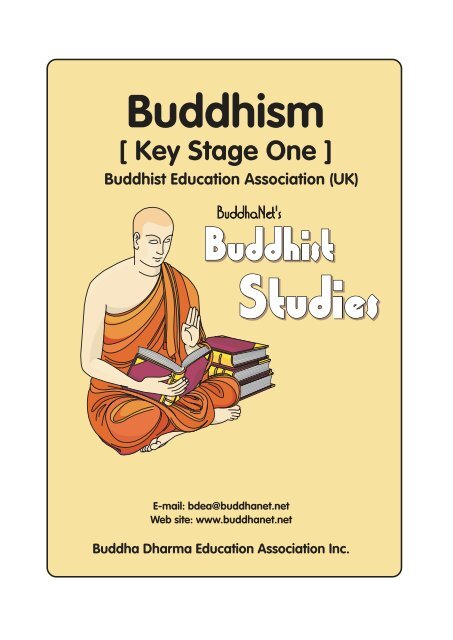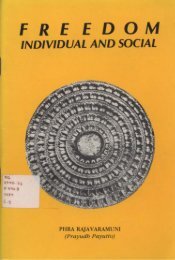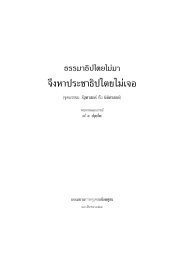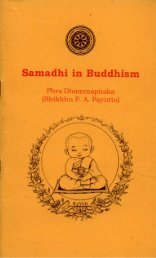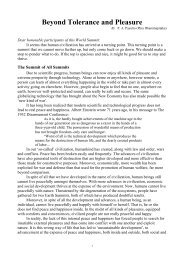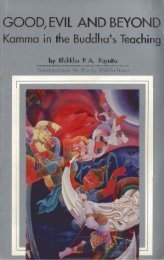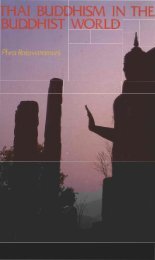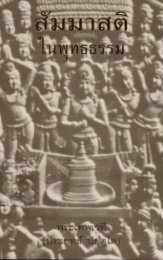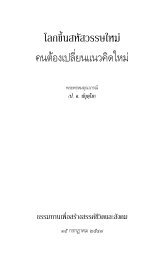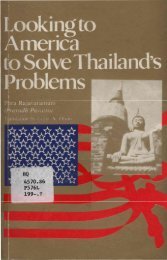You also want an ePaper? Increase the reach of your titles
YUMPU automatically turns print PDFs into web optimized ePapers that Google loves.
<strong>Buddhism</strong><br />
[ <strong>Key</strong> <strong>Stage</strong> <strong>One</strong> ]<br />
Buddhist Education Association (UK)<br />
E-mail: bdea@buddhanet.net<br />
Web site: www.buddhanet.net<br />
Buddha Dharma Education Association Inc.
By<br />
Jing Yin<br />
Ken Hudson<br />
Published by<br />
Buddhist Education Foundation (UK)<br />
Registered Charity No.: 1073008<br />
2000
First published in Great Britain in 2000<br />
by<br />
Buddhist Education Foundation (UK)<br />
This is a complimentary Buddhist textbook,<br />
which can be obtained from<br />
The Buddhist Education Foundation (UK)<br />
BCM 9459<br />
London WC1N 3XX<br />
United Kingdom<br />
www.buddhisteducation.co.uk<br />
info@buddhisteducation.co.uk<br />
Registered Charity No.: 1073008<br />
ISBN 0 9536928 0 9<br />
Illustrated by Yanfeng Liu<br />
Produced by media 2000
Preface<br />
The present publication constitutes the first out of four<br />
textbooks on <strong>Buddhism</strong> devised for children between<br />
five and seven years of age. The primary aims of these<br />
textbooks are to help young pupils to acquire the<br />
essential knowledge about the life of the Buddha, his<br />
fundamental teaching and the historical development<br />
of <strong>Buddhism</strong>. The information is basically factual,<br />
although it places a marked emphasis on the salient<br />
character of Buddhist morality and its constructive<br />
attitude towards people and society.<br />
<strong>Buddhism</strong> for <strong>Key</strong> <strong>Stage</strong> <strong>One</strong> provides an introduction<br />
to the basic concept of the Triple Gem, namely<br />
the Buddha, the Dharma and the Sangha. These three<br />
elements constitute the three pillars of <strong>Buddhism</strong>.<br />
The Buddha is the founder and teacher, the Dharma<br />
represents the Buddha’s teachings, and the Sangha<br />
denotes the Buddhist community as a whole, living in<br />
accordance with the Buddha’s teachings. In addition<br />
to these three elements covered in separate chapters,<br />
the textbook also includes ten selected Buddhist stories,<br />
which are to serve as additional aids to help the pupils<br />
gain a better grasp of Buddhist principles and see their<br />
application in various contexts.<br />
The accompanying Pupil’s Workbook contains<br />
various types of exercises based on standard teaching<br />
methods. They are intended for revision purposes and<br />
should be used at the discretion of the teacher. The<br />
5
English grammar and vocabulary are adapted to the level<br />
of an average pupil of <strong>Key</strong> <strong>Stage</strong> <strong>One</strong>. However, some<br />
pupils may need further assistance with the reading of<br />
this book. All Buddhist terms, printed in blue, (which<br />
are hyperlinked in this PDF) are listed in the glossary.<br />
The subjects covered in this and the remaining<br />
issues of this series are in accordance with the syllabus<br />
prescribed in the UK by the revised National Curriculum<br />
in 1994.<br />
This textbook is produced by the Buddhist Education<br />
Foundation. It is a charitable organisation which<br />
aims to promote the education of <strong>Buddhism</strong> in this<br />
country.<br />
The authors of the text are Jing Yin and Ken Hudson.<br />
Jing Yin is a Buddhist monk from China. He studied<br />
<strong>Buddhism</strong> in China and Sri Lanka. Currently he is in<br />
his final year of his Ph.D. programme at the School of<br />
Oriental and African Studies, University of London. He<br />
is being supervised by Dr T. Skorupski, who has also<br />
been consulted in matters relating to this textbook. Ken<br />
Hudson has taught in Australia, Canada and England for<br />
more than 20 years. Liu Yanfeng, a professional artist,<br />
has done the illustrations.<br />
We would appreciate receiving feedback from both<br />
teachers and pupils about this first edition with a view<br />
to improving the material for the next edition<br />
President<br />
The Buddhist Education Foundation (UK)<br />
6
Contents<br />
Preface . . . . . . . . . . . . . . . . . . . . . . . . . . . . . . . . . . . . . . . . . . 5<br />
The Buddha . . . . . . . . . . . . . . . . . . . . . . . . . . . . . . 9<br />
The Dharma . . . . . . . . . . . . . . . . . . . . . . . . . . . . . 27<br />
The Sangha . . . . . . . . . . . . . . . . . . . . . . . . . . . . . . 37<br />
The Triple Gem . . . . . . . . . . . . . . . . . . . . . . 42<br />
Buddhist Stories . . . . . . . . . . . . . . . . . . . 47<br />
Wild Deer Park<br />
No killing . . . . . . . . . . . . . . . . . . . . . . . . . . . . . . . . . . . . . 48<br />
The Moon is Looking at You<br />
No stealing . . . . . . . . . . . . . . . . . . . . . . . . . . . . . . . . . . . 50<br />
The Buddha and Rahula<br />
No lying . . . . . . . . . . . . . . . . . . . . . . . . . . . . . . . . . . . . . . . 52<br />
7
The Young Deer that Played Dead<br />
Respecting Teachers . . . . . . . . . . . . . . . . . . . . . 54<br />
The Buddha Threading the Needle<br />
Helping each other . . . . . . . . . . . . . . . . . . . . . . . 56<br />
The Crippled Man & the Blind Man<br />
Helping each other . . . . . . . . . . . . . . . . . . . . . . . 58<br />
The Fishmonger’s<br />
Making good friends . . . . . . . . . . . . . . . . . . . . . 60<br />
The Fox and the Otters<br />
Do not be selfish . . . . . . . . . . . . . . . . . . . . . . . . . . . 62<br />
The Snake’s Head and Tail<br />
Do not fight with each other . . . . . . . . . 64<br />
The Cleaning Woman<br />
Clean mind . . . . . . . . . . . . . . . . . . . . . . . . . . . . . . . . . . 66<br />
Glossary . . . . . . . . . . . . . . . . . . . . . . . . . . . . . . . . . . . . . . . 68<br />
Index . . . . . . . . . . . . . . . . . . . . . . . . . . . . . . . . . . . . . . . . . . . . 69<br />
Bibliography . . . . . . . . . . . . . . . . . . . . . . . . . . . . . . . . 70<br />
8
The Buddha<br />
Tian Tan Buddha Statue in Po Lin Monastery Hong Kong<br />
<strong>Buddhism</strong> is the teachings of the Buddha.<br />
He was a wise teacher. His teachings help<br />
people to live wisely and happily. Today,<br />
more than 500 million people in the world<br />
follow his teachings. In this unit, we are<br />
going to tell you the story of the Buddha.<br />
9
About 2,600 years ago, there lived a great<br />
king named Suddhodana. He had a pretty<br />
wife called Maya. They lived at the bottom<br />
of the Himalayan Mountains in northern<br />
India.<br />
10
<strong>One</strong> night, Queen Maya had a wonderful<br />
dream. She saw a huge white elephant come<br />
into her room. It was holding a lotus flower.<br />
The elephant blew its trunk as it was walking<br />
round her bed three times.<br />
11
In the morning, the king asked his wise<br />
men about the queen’s dream. They said,<br />
“Oh King! A great son will be born to Queen<br />
Maya.” The king and queen were very happy<br />
with this news.<br />
12
Queen Maya gave birth to Prince Siddhartha<br />
in a pretty royal park. It was the full-moon<br />
day of May. All the trees were in flower. The<br />
bees were humming around the fresh flowers.<br />
The birds were singing sweetly. Everyone<br />
was happy because a prince had been born.<br />
13
The prince was very kind. He never hurt<br />
anything, not even the smallest animals.<br />
14
<strong>One</strong> day, his cousin shot a swan. It fell to the<br />
ground and was badly hurt. The prince felt<br />
sorry for it. He picked it up and looked after<br />
it. He knew that all animals wanted to live.<br />
They did not want to die.<br />
15
In the palace, the prince had many teachers.<br />
He was a very good student. His father<br />
wished that one day he would become a<br />
great king.<br />
16
The prince grew up to be a strong, handsome,<br />
young man. He married a beautiful girl. They<br />
lived happily together.<br />
17
<strong>One</strong> day, when the prince visited a village,<br />
he saw four people: one sick, one old, one<br />
dead and a holy man. The first three made<br />
him very sad. The holy man made him think<br />
about what it meant to be happy.<br />
18
At the age of twenty-nine, the prince gave<br />
up his palace life. He left his family to find a<br />
way to make everyone happy.<br />
19
For the next six years, he went from place<br />
to place. He learnt from many wise teachers.<br />
He had a lot of hardship, but he did not give<br />
up. He kept looking for a way to get rid of<br />
sadness in the world. He became wiser day<br />
by day.<br />
20
At last, he sat under a huge Bodhi Tree. He<br />
meditated over and over on these questions,<br />
“Why do people suffer? How can I help them<br />
to be happy?”<br />
21
At the age of thirty-five, he found a way for<br />
people to end their pain and sadness. From<br />
then on, he was called the Buddha.<br />
22
The Buddha first told his ideas to five monks,<br />
“There are problems in all our lives. These<br />
problems come from being selfish. If we get<br />
rid of being selfish, we could be wise and<br />
happy.”<br />
23
For the next forty-five years, many people,<br />
rich and poor, young and old, came to listen<br />
to the Buddha’s teachings, “We should<br />
always think about what we do. If we do good,<br />
good things will happen to us. If we do bad,<br />
bad things will happen to us.”<br />
24
At the age of eighty, the Buddha passed away.<br />
25
The Dharma<br />
The main teachings of the Buddha are:<br />
— Do NOT Do Bad<br />
— Do Good<br />
— Keep Your Mind Clean<br />
Monks & nuns from Fa Yue Buddhist Monastery in Birmingham,<br />
UK teaching Dharma to school children<br />
Dharma is the teachings of the Buddha. It<br />
teaches us how to live wisely and happily.<br />
It tells us how to face and solve problems.<br />
When we follow the Dharma, it brings much<br />
happiness and peace.<br />
27
Do NOT Do Bad<br />
Killing animals and being cruel to them is<br />
bad. Like us, animals do not want to get<br />
hurt. We should not harm them; not even<br />
just for fun.<br />
28
Do NOT Do Bad<br />
Stealing is bad. People who have their money<br />
or things stolen will be very sad. Those who<br />
steal will be punished for it.<br />
29
Do NOT Do Bad<br />
Telling lies is bad. Telling lies even for fun<br />
may get people into trouble. We should<br />
always tell the truth.<br />
30
Do GOOD<br />
We should respect our parents and teachers.<br />
They are ready to help us and give us good<br />
advice. They deserve our respect.<br />
31
Do GOOD<br />
We should help one another. Everyone needs<br />
help at times. Helping each other will make<br />
everybody happy.<br />
32
Do GOOD<br />
We should make friends with good people.<br />
They will help us to become better people.<br />
It is best to keep away from people who do<br />
bad.<br />
33
Keep Your Mind Clean<br />
Selfish thoughts make your mind unclean.<br />
When people are selfish, they only think<br />
about themselves. No one likes selfish people.<br />
We should not have selfish thoughts.<br />
34
Keep Your Mind Clean<br />
Don’t be greedy as it makes your mind<br />
unclean. When a greedy boy eats too much,<br />
he gets ill and feels terrible. In the same<br />
way, wanting too much of anything, such<br />
as toys and games, is not good for us. We<br />
should not have greedy thoughts.<br />
35
Keep Your Mind Clean<br />
Angry thoughts make your mind unclean.<br />
When we lose our temper easily, we upset<br />
other people. Then no one wants to be our<br />
friend and we will be sad. So we should not<br />
have angry thoughts.<br />
36
The Sangha<br />
Monks & nuns from Amaravati Buddhist Monastery,<br />
Hemel Hempstead, U.K.<br />
The Sangha is a group of monks or nuns.<br />
They practise the Dharma. They hope that<br />
the Buddha’s teachings can help to make<br />
people become happier and wiser. They<br />
want everyone to live a good and happy life.<br />
37
Men can become monks. Monks usually get<br />
up at 5 o’clock in the morning. They study<br />
the Buddha’s teachings after breakfast. Sometimes,<br />
they teach Dharma to people in the<br />
afternoon. In the evening, they meditate. They<br />
keep their minds clean and have kind hearts.<br />
38
Women can become nuns. They also shave<br />
their heads. They usually wear robes of<br />
brown, yellow or grey. They live simple lives<br />
and work hard for the happiness of people.<br />
They are wise and cheerful, just like the<br />
monks.<br />
39
People who are not monks or nuns can also<br />
study the Buddha’s teachings. They are called<br />
lay people. They respect the Buddha, the<br />
Dharma and the Sangha. They are friendly<br />
and peaceful to everybody.<br />
40
When lay people have problems, they go<br />
to monks and nuns for advice. To thank<br />
them for their good advice, lay people offer<br />
monks and nuns food and clothing as a sign<br />
of respect. They treat monks and nuns as<br />
special people.<br />
41
The Triple Gem<br />
The Buddha, the Dharma and the Sangha are<br />
called the Triple Gem. The Triple Gem is<br />
very special to Buddhists. They pay respect to<br />
the Buddha, learn the Dharma, and follow the<br />
advice of the Sangha. By doing this, Buddhists<br />
believe they can become wise and happy.<br />
42
The Buddha is the first gem for Buddhists.<br />
– He is the founder of <strong>Buddhism</strong>.<br />
– He found the Truth.<br />
– He is the most honoured person in <strong>Buddhism</strong>.<br />
– He represents wisdom.<br />
– He taught us how to find happiness<br />
through wisdom and love.<br />
43
The Dharma is the second gem for Buddhists.<br />
– It is the teachings of the Buddha.<br />
– It shows the Truth.<br />
– It helps us to gain happiness.<br />
44
The Sangha is the third gem for Buddhists.<br />
– It is a group of monks or nuns.<br />
– It represents purity.<br />
– It sets a good example for Buddhists to follow.<br />
45
Buddhist Stories<br />
Some of the Buddha’s teachings are very<br />
deep and difficult to understand. So when<br />
the Buddha was alive, he often used stories<br />
to help people to understand his teachings.<br />
The following ten stories will help you understand<br />
better his teachings in this book.<br />
47
Wild Deer Park<br />
No killing<br />
A long time ago, there was a beautiful<br />
forest. Many deer lived there. <strong>One</strong><br />
day, a king took his men there to hunt.<br />
The king shot an arrow and hit a<br />
mother deer. She ran away in pain. Later<br />
the king found her hiding in some bushes<br />
with her baby deer. Even though she was<br />
bleeding and had tears in her eyes, she still<br />
fed her baby with milk. She soon died.<br />
The king felt very sorry. He picked up<br />
the baby deer and said to it, “I will now care<br />
for you.” He then broke his bow in two. He<br />
said, “I’ll never hunt again.”<br />
To remember that day, he named the<br />
forest Wild Deer Park.<br />
Like people, animals also have feelings.<br />
We should not kill them for<br />
fun or sport. It is unkind and selfish.<br />
48
The Moon is Looking at You<br />
No stealing<br />
Once there was a very poor family. They<br />
often went to their neighbour’s garden to<br />
steal some vegetables.<br />
<strong>One</strong> night, the father took along his little<br />
son into their neighbour’s garden to steal<br />
some carrots. While the father was pulling<br />
out some carrots, his little boy stood beside<br />
him. Suddenly, his son whispered, “Daddy,<br />
someone is looking at us.”<br />
The father became afraid. He quickly<br />
looked around but he could not see anyone.<br />
“Where? Who?” he asked.<br />
The son pointed at the sky, “There, Daddy.<br />
It’s the moon. The moon is looking at us.”<br />
The father was shocked by what his son<br />
said. He thought that nobody could see what<br />
he was doing at night. His son’s words made<br />
him feel ashamed.<br />
He threw the carrots down and took his<br />
son by the hand. They both walked back<br />
home in the moonlight. After that he never<br />
stole anything again.<br />
If we steal, people will know.<br />
50
The Buddha and Rahula<br />
No lying<br />
Rahula, the only son of the Buddha, became<br />
a monk. He was the youngest in the Sangha.<br />
All the monks loved and spoiled him. Rahula<br />
did whatever he liked. Sometimes he told<br />
lies just for the fun of it.<br />
<strong>One</strong> day, the Buddha said to Rahula,<br />
“Please bring me a basin of water. I want to<br />
wash my feet.” He washed his feet in the<br />
basin of water and asked Rahula, “Would<br />
you drink this water?”<br />
52
“No, it’s dirty!” Rahula replied.<br />
Then the Buddha asked Rahula to throw<br />
the water away.<br />
The Buddha told Rahula, “When water<br />
gets dirty, no one wants it. It is the same for<br />
those who tell lies, no one cares for them<br />
anymore.”<br />
Tears of shame come to Rahula’s eyes.<br />
He never told another lie.<br />
We should always tell the truth.<br />
53
The Young Deer that Played Dead<br />
Respecting Teachers<br />
A wise deer taught all the young deer how to<br />
escape from the hunters. <strong>One</strong> of them was a<br />
very good pupil. He was never bad in class. He<br />
also thanked the teacher after every lesson.<br />
<strong>One</strong> day, this young deer was caught in<br />
a trap. The others ran away in fright. They<br />
ran to tell his mother. She cried when she<br />
heard about this.<br />
The teacher comforted her, “Don’t worry.<br />
Your son is such a good pupil, he will come<br />
back safely.”<br />
54
As he was caught in the trap, the young<br />
deer remembered what the teacher had<br />
taught him. He pretended to be dead by<br />
sticking out his tongue and lying still. This<br />
made the hunter believe that the deer was<br />
really dead. When the hunter was preparing<br />
to cook the deer, it jumped up and ran away<br />
like the wind. His friends were so happy to<br />
see him back. They thanked the wise teacher<br />
for teaching him so well.<br />
Being a good pupil brings great<br />
rewards.<br />
55
The Buddha Threading the Needle<br />
Helping each other<br />
Anuruddha was a very good pupil, but he<br />
was blind. He did not feel sorry for himself<br />
because he was blind and kept up with his<br />
practice.<br />
<strong>One</strong> day, he felt a hole in his robe. He<br />
tried to mend it, but found it very difficult.<br />
He could not even thread the needle. The<br />
Buddha came to his room to thread the<br />
needle for him. “Who is threading the needle<br />
for me?” Anuruddha asked.<br />
“It is the Buddha,” the Buddha replied<br />
while he was mending the robe. Anuruddha<br />
felt really happy and was moved to tears.<br />
Always help those who need it.<br />
56
The Crippled Man & the Blind Man<br />
Helping each other<br />
A crippled man and a blind man were left<br />
alone in a house. A fire broke out. Both were<br />
very scared. The blind man could not see the<br />
way out. The crippled man could not walk<br />
to it.<br />
58
They decided to help each other. The blind<br />
man carried the crippled man on his back.<br />
The crippled man told the blind man where<br />
to go. Together, they got out of the burning<br />
house.<br />
If we help each other, we will all win.<br />
59
The Fishmonger’s<br />
Making good friends<br />
The Buddha and Ananda were begging in a<br />
city. They passed a fishmonger’s. The Buddha<br />
said, “Ananda, touch the rope where the fish<br />
are hanging and smell your fingers.”<br />
Ananda did this and said, “It smells<br />
awful!”<br />
60
The Buddha said, “This is the same with<br />
making friends, if you mix with bad people,<br />
you will become bad. This is like the smell<br />
from the rope in the fishmonger’s.”<br />
Next, they passed a spice shop. The<br />
Buddha said, “Ananda, touch the spice<br />
wrapper and then smell your fingers.”<br />
Ananda did this and said, “My fingers<br />
smell very nice.”<br />
The Buddha said, “This is the same with<br />
making friends. If you mix with good people,<br />
you will be a good person. This is like the nice<br />
smell you got from the spice wrappers.”<br />
If you mix with good and honest<br />
people, you will be a good person.<br />
If you mix with lazy and bad<br />
people, you will be a bad person.<br />
61
The Fox and the Otters<br />
Do not be selfish<br />
A fox’s wife wanted to eat some fresh fish.<br />
The fox tried to find some for her near the<br />
river. He saw two otters at the river dragging<br />
along a big fish. Both wanted the best parts<br />
of the fish. The fox watched them for a short<br />
time. Then he went up to ask if he could<br />
divide the fish for them. The otters were<br />
delighted.<br />
62
The fox divided the fish into three pieces. He<br />
gave the head to one otter and the tail to the<br />
other. While the otters were thinking how<br />
the fox would divide the best part of the fish,<br />
the fox ran away with it. The otters had only<br />
themselves to blame for being so selfish.<br />
Do not be selfish, share with others.<br />
63
The Snake’s Head and Tail<br />
Do not fight with each other<br />
The snake’s tail had a fight with its head. The<br />
tail said, “You have led me for so long. Now<br />
it’s time for me to lead you.”<br />
The head said, “I should be the leader.<br />
I have eyes and a mouth.”<br />
The tail said, “You need me to move.<br />
Without me, you can’t go anywhere.”<br />
Then the tail grabbed a tree branch and<br />
would not let go. The snake’s head gave up<br />
and let the tail be the leader. The head did<br />
not want to help the tail. The tail could not<br />
see where it was going. Then, it fell into a<br />
fire pit. The snake was burnt to death.<br />
It hurts both sides when you quarrel.<br />
64
The Cleaning Woman<br />
Clean mind<br />
A woman worked very hard cleaning the<br />
streets. As her clothes were dirty and smelly,<br />
all the people ran away from her when they<br />
saw her. When the Buddha talked to her<br />
nicely, the people were surprised.<br />
66
They asked the Buddha, “You always ask us<br />
to be clean. Why are you talking to this smelly<br />
woman?”<br />
The Buddha replied, “Although this<br />
woman is smelly, her mind is clean. She is<br />
polite and she works hard for others. Some<br />
people look clean and tidy, but their minds<br />
are full of bad thoughts!”<br />
Having a clean mind is more important<br />
than wearing clean clothes.<br />
67
Glossary<br />
Ananda a monk who had a good memory<br />
Anuruddha a monk who went blind<br />
Bodhi Tree the tree under which Prince<br />
Siddhartha became the Buddha<br />
Buddha a wise teacher<br />
Dharma the teachings of the Buddha<br />
Lay people Buddhists who are not monks & nuns<br />
Maya the Buddha’s mother<br />
Monk a male Buddhist who has left home<br />
to live and practise in a monastery<br />
Nun a female Buddhist who has left home<br />
to live and practise in a nunnery<br />
Rahula the Buddha’s son<br />
Sangha a group of Buddhist monks or nuns<br />
Siddhartha the name of the prince before he<br />
became the Buddha<br />
Suddhodana the Buddha’s father<br />
Sutras talks given by the Buddha<br />
Triple Gem the Buddha, the Dharma & the Sangha<br />
68
Index<br />
Ananda ............................................................................................................ 60<br />
Anuruddha .............................................................................................. 56<br />
Bodhi Tree ................................................................................................ 21<br />
Buddha ............................................................................................................ 9<br />
Dharma ........................................................................................................... 27<br />
Lay People ................................................................................................. 40<br />
Maya ..................................................................................................................... 10<br />
Monk .................................................................................................................... 37<br />
Nun ......................................................................................................................... 37<br />
Rahula .............................................................................................................. 52<br />
Sangha ............................................................................................................. 37<br />
Siddhartha ............................................................................................... 13<br />
Suddhodana .......................................................................................... 10<br />
Sutras ................................................................................................................. 44<br />
Triple Gem ............................................................................................... 42<br />
69
Bibliography<br />
Conze, E. <strong>Buddhism</strong>: Its Essence and<br />
Development. London, Harper Torchbooks,<br />
1975.<br />
Conze, E. A Short History of <strong>Buddhism</strong>.<br />
Oxford, 1993.<br />
Rahula, W. What the Buddha Taught.<br />
London, 1978.<br />
Warder, A. K. Indian <strong>Buddhism</strong>. Delhi,<br />
Motilal Banarsidass, 1980.<br />
Wijayaratna, M. Buddhist Monastic Life<br />
according to the texts of the Theravada<br />
Tradition. Cambridge, 1990.<br />
70


